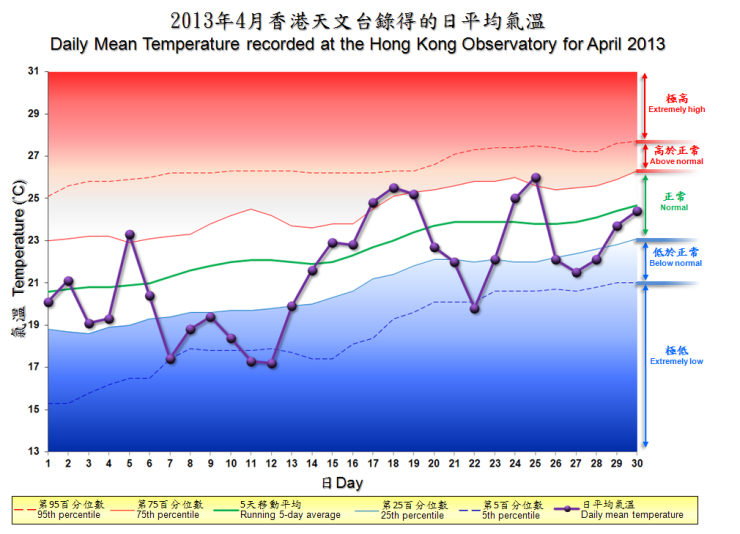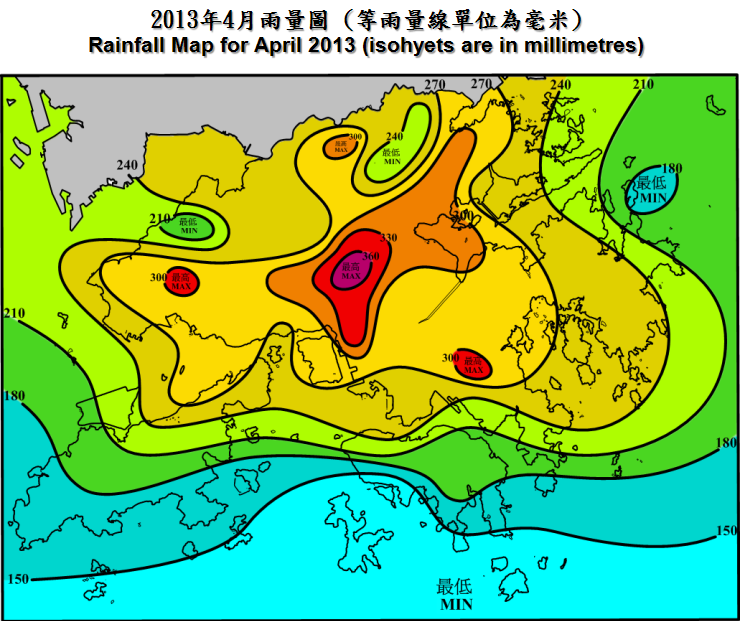The Weather of April 2013
April 2013 was marked by gloomy and unstable weather which were mainly attributed to the frequent interchange of the cooler northeast monsoon and the humid maritime airstream over the south China coast in the month. The month was more thundery than usual with 8 thunderstorm days, about 4 days more than normal. The sun only shone for 53.6 hours in the month, about 53 percent of the normal total duration of bright sunshine. The total rainfall in the month was 253.8 millimetres, 79.1 millimetres above the normal amount. The accumulated rainfall since the beginning of the year was 389.2 millimetres, about 16 percent above the normal figure of 336.0 millimetres.  Radar echoes showing that a squall line was crossing the territory at 2:48pm on 30 April 2013.  Fast moving squall line passing over Tsuen Wan in the afternoon on 30 April 2013. (Photo courtesy of Ms. Christina Chan). |
|
There was no tropical cyclone over the South China Sea and the western North Pacific in the month. |
|
Details of issuance and cancellation of various warnings/signals in the month are summarized in Tables 1.1 to 1.4. Monthly meteorological figures and departures from normal for April are tabulated in Table 2. |
Warnings and Signals issued in April 2013
| Beginning Time | Ending Time | ||
|---|---|---|---|
| Day/Month | HKT | Day/Month | HKT |
| 3 / 4 | 0615 | 3 / 4 | 1400 |
| 6 / 4 | 0720 | 6 / 4 | 1225 |
| 6 / 4 | 1930 | 7 / 4 | 0400 |
| 26 / 4 | 2030 | 27 / 4 | 0745 |
| Colour | Beginning Time | Ending Time | ||
|---|---|---|---|---|
| Day/Month | HKT | Day/Month | HKT | |
| Amber | 5 / 4 | 0840 | 5 / 4 | 1030 |
| Amber | 6 / 4 | 0000 | 6 / 4 | 0230 |
| Amber | 25 / 4 | 1930 | 25 / 4 | 2100 |
| Amber | 30 / 4 | 1420 | 30 / 4 | 1615 |
| Beginning Time | Ending Time | ||
|---|---|---|---|
| Day/Month | HKT | Day/Month | HKT |
| 2 / 4 | 1215 | 2 / 4 | 1715 |
| 4 / 4 | 1740 | 4 / 4 | 1900 |
| 5 / 4 | 0130 | 5 / 4 | 0530 |
| 5 / 4 | 0705 | 5 / 4 | 1030 |
| 5 / 4 | 2320 | 6 / 4 | 0300 |
| 9 / 4 | 0747 | 9 / 4 | 0915 |
| 9 / 4 | 1131 | 9 / 4 | 1245 |
| 9 / 4 | 1930 | 10 / 4 | 0600 |
| 10 / 4 | 1615 | 10 / 4 | 1745 |
| 12 / 4 | 0335 | 12 / 4 | 0430 |
| 17 / 4 | 1115 | 17 / 4 | 1730 |
| 18 / 4 | 1420 | 18 / 4 | 1930 |
| 19 / 4 | 0225 | 19 / 4 | 0600 |
| 19 / 4 | 1615 | 19 / 4 | 2145 |
| 20 / 4 | 2200 | 21 / 4 | 0200 |
| 25 / 4 | 1830 | 25 / 4 | 2200 |
| 30 / 4 | 1400 | 30 / 4 | 1800 |
| Colour | Beginning Time | Ending Time | ||
|---|---|---|---|---|
| Day/Month | HKT | Day/Month | HKT | |
| Yellow | 7 / 4 | 0600 | 7 / 4 | 1800 |
| Yellow | 13 / 4 | 0600 | 13 / 4 | 1800 |
| Yellow | 14 / 4 | 0630 | 14 / 4 | 2030 |
| Meteorological Element | Figure of the Month | Departure from Normal* |
|---|---|---|
| Mean Daily Maximum Air Temperature | 23.9 degrees C | 1.1 degrees below normal |
| Mean Air Temperature | 21.5 degrees C | 1.1 degrees below normal |
| Mean Daily Minimum Air Temperature | 19.7 degrees C | 1.1 degrees below normal |
| Mean Dew Point Temperature | 19.0 degrees C | 0.4 degree below normal |
| Mean Relative Humidity | 86 % | 3 % above normal |
| Mean Cloud Amount | 81 % | normal |
| Total Rainfall | 253.8 mm | 79.1 mm above normal |
| Number of hours of Reduced VisibilityΔ | 98 hours | 2.2 hours above normal§ |
| Total Bright Sunshine Duration | 53.6 hours | 48.1 hours below normal |
| Mean Daily Global Solar Radiation | 8.98 Megajoule / square metre | 2.62 Megajoule below normal |
| Total Evaporation | 64.6 mm | 19.2 mm below normal |
| Remarks : | All measurements were made at the Hong Kong Observatory except sunshine, solar radiation and evaporation which were recorded at King's Park Meteorological Station and visibility which was observed at the Hong Kong International Airport. |
| Δ |
The visibility readings at the Hong Kong International Airport are based on hourly observations by professional meteorological observers in 2004 and before, and average readings over the 10-minute period before the clock hour of the visibility meter near the middle of the south runway from 2005 onwards. The change of the data source in 2005 is an improvement of the visibility assessment using instrumented observations following the international trend. |
* Departure from 1981 - 2010 climatological normal, except for number of hours of reduced visibility |
|
§ Departure from mean value between 1997 and 2012 |
|


| Remarks : | Extremely high: above 95th percentile Above normal: between 75th and 95th percentile Normal: between 25th and 75th percentile Below normal: between 5th and 25th percentile Extremely low: below 5th percentile Percentile and 5-day running average values are computed based on the data from 1981 to 2010 |
